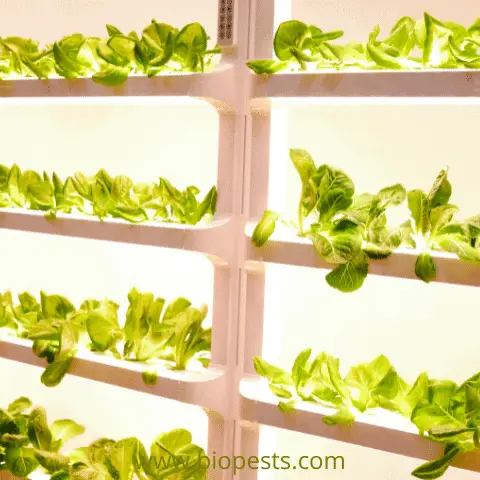Not even hydroponics can prevent you from dealing with harmful bugs. If you’re not paying attention to your plant’s health, you could end up with an infestation that’s difficult to manage. Fortunately, there are several things you can do to counter and prevent pests.
Here’s how you can get rid of bugs in hydroponic water:
- Introduce helpful predatory insects.
- Use organic pesticides.
- Identify the bugs and take specific measures.
- Keep predators around to prevent future pests.
If your hydroponic system is suffering from a bug infestation, never fear! This article will show you how to get rid of harmful pests and prevent them from coming back. Read on to find out more.
How You Can Get Rid of Bugs in Hydroponic Water
The first part of getting rid of harmful bugs is knowing what they are. After that, you can search for the best way to combat them specifically.
There are 2 main control methods for domestic hydroponic systems: biological control and chemical control. Biological control involves introducing beneficial insects that fight the pest, while chemical control includes using things like pesticides.
Below are effective ways to remove bugs in hydroponic water:
1. Introduce Helpful Predatory Insects
Many insects predate on the bugs that are damaging your plants. The first thing you should do is identify which pests are infesting your garden. You can then pick the right predators for the bug.
After you’ve chosen the right allies to help you get rid of the bugs, then you can introduce them to your hydroponic system. There are 3 different ways you can go about this:
- Conservation. This means attracting and preserving the beneficial organism that naturally appears in your plants.
- Inoculation. Inoculating means releasing small quantities of the beneficial organism over time.
- Inundation. This implies releasing large amounts of the beneficial organism simultaneously, an option reserved for when the pest has already gotten out of control.
Consider introducing control organisms before the pest appears. Biological control can be slower to take effect, and the pest might have gotten out of control by the time it happens.
Here’s a chart showing you which predator insects are right for each kind of pest insect. You can get these helpful bugs through sellers like Biobest and Koppert.
The pros: They’ll only kill specific harmful organisms.There’s no risk of pests developing resistance.This method is safer for your plants.
The cons: Since hunters need to keep eating, they won’t eradicate the pest.By the time you introduce the control organism, the pest might have grown.
2. Use Organic Pesticides
Chemical control allows you to take immediate action on the pests. However, you might worry about using strong chemicals on your hydroponics.
If that’s the case, don’t worry. There are plenty of organic and homemade options like soaps and natural chemicals for you to use. I’ll explain the best methods to kill different bugs below.
Pesticides will give you fast results, but they can also kill many bugs beneficial to your plants. For example, they may kill insects that mitigate the growth of the pests, leaving your plants more vulnerable.
Bugs can develop resistance to pesticides, so only use them in the recommended doses. To reduce the risk of a pest developing resistance, use them alternately between different pesticides.
Don’t think a pesticide isn’t toxic just because it says it’s organic. Many organic pesticides can be even more harmful than artificial ones. Chemical poisons should only be used as a last resort.
Pros:
They can get completely rid of the infestation.You can apply them instantly before the pests have the chance to grow.
Cons:
Organic pesticides can kill beneficial organisms, too.Pests can develop resistance to pesticides in the long run.
3. Identify the Bugs and Take Specific Measures
Identifying the tiny bugs floating in your hydroponic water can be difficult. To determine the species of a bug that’s causing you trouble, look at it under a microscope or a magnifying glass and compare what you see with pictures in manuals and guides.
These are some of the most common pests in hydroponic systems and how to get rid of them:
Spider Mites
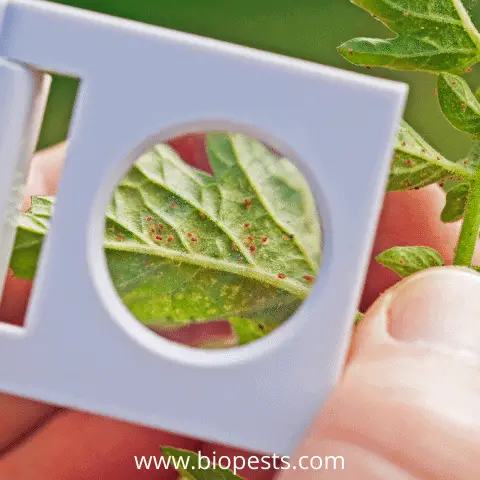
Spider mites are tiny arachnids under 0.4 mm (0.02 in) long. Their most identifiable trait is their bright red coloring.
These mites pierce the leaves with their mouths and feed off the content inside the plant’s cells, leaving behind their walls like an empty husk.
Don’t confuse spider mites with normal spiders! Spiders are beneficial for your plants and can keep many pests at bay.
Tips for getting rid of spider mites:
- Introduce persimilis mites in your greenhouse. Keep the environment between 55°F (12.78°C) and 85°F (29.44°C). If you can’t avoid warmer conditions, consider the swirski mite.
- Use insecticide soaps and oils. These substances work only on contact, so you’ll have to cover the upper and lower parts of the leaves.
Aphids
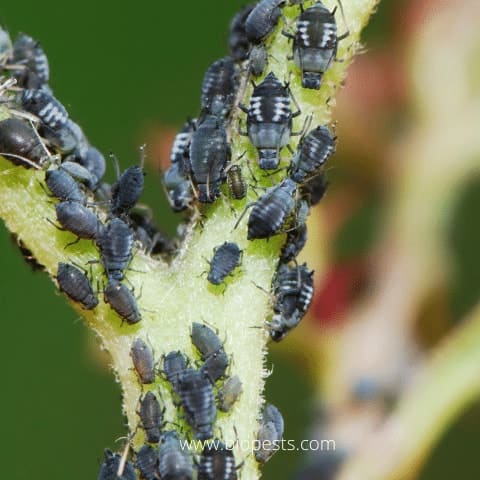
Aphids reproduce quickly and can be a vector for diseases. They have piercing mouthparts, and they often inject toxins into the plants they feed off.
Tips for getting rid of aphids:
- Use ladybugs to hunt them. They and their larvae feed on aphids. Lacewing larvae can also be very effective. You can release these insects specifically on infested plants.
- Apply insecticide oils and soaps. A more powerful alternative is the natural compound pyrethrin. However, it can cause beneficial species to flee temporarily.
Whiteflies
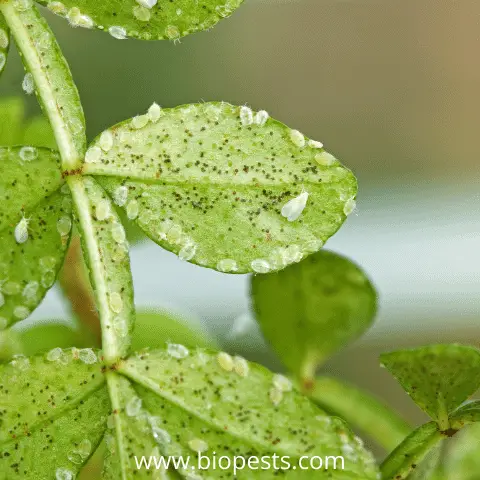
Whiteflies look like tiny white moths and feed off a plant’s sap. They secrete a sticky honeydew where sooty mold tends to grow.
Tips for getting rid of whiteflies:
- Introduce lacewings and big-eyed bugs.
- Place some sticky plants around your plants to catch adult whiteflies before they lay eggs.
- Thoroughly spray your plants with neem oil or insecticidal soaps.
Thrips
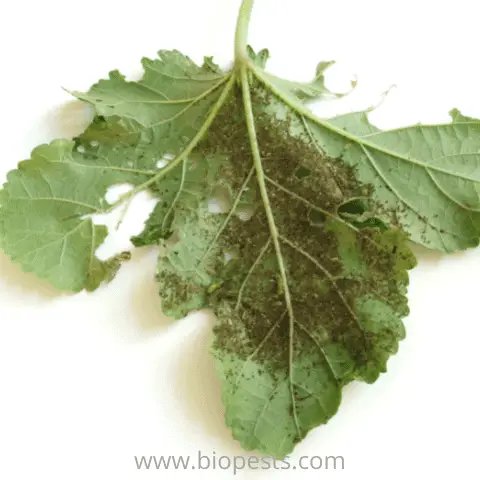
Thrips are slender and less than 2 mm (0.05 in) long. As they feed on a plant, they can stunt its growth. They insert their eggs into stems and leaves and are mostly drawn towards flowers.
Tips for getting rid of thrips:
- Introduce predatory thrips or green lacewings. Some parasitic wasps are also common predators of thrips.
- Use fatty acids containing potassium salts. They can destroy the thrips’ exoskeletons.
4. Keep Predators Around To Prevent Future Pests
You’ll likely have to deal with harmful bugs again. Instead of waiting for it to happen, you can take preventive measures to mitigate the next infestation or even prevent it entirely.
Many pests can be extremely difficult to deal with once they’ve reached a certain growth. To stop this from happening, keep beneficial bugs around your plants. If you detect an infestation that seems to grow rapidly, apply insecticide soap or a natural oil thoroughly to the plant.
Many pests thrive on outdoor plants. Be careful not to bring bugs like aphids when you take your garden tools near your hydroponic plants.
Final Thoughts
Hydroponic systems require constant vigilance. You must keep an eye on your plants and respond quickly and ruthlessly to any unwanted insect guests.
Fortunately, these pests can be disposed of with relative ease if you catch the infestation in time. Now that you know what to look for and how to deal with insect intruders when you spot them, you should have no trouble keeping your hydroponic system free of harmful bugs.
Some of the links above are affiliate links, meaning at no additional cost to you, I will earn a commission if you click through and made a purchase.

